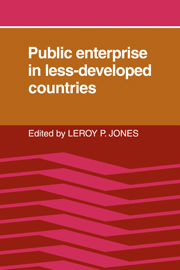Book contents
- Frontmatter
- Contents
- List of contributors
- List of figures and tables
- Preface
- 1 Introduction
- Part I Why public enterprise?
- Part II Principal-agent relationships: Who should control public enterprises?
- Part III How are decisions made in practice?
- Part IV How do public enterprises behave in international markets?
- Part V How does risk alter public-enterprise decisions?
- Part VI How are incentive structures to be designed?
- Part VII How does public enterprise compare with other intervention mechanisms in overcoming particular problems?
- 16 Public enterprise versus other methods of state intervention as instruments of redistribution policy: the Malaysian experience
16 - Public enterprise versus other methods of state intervention as instruments of redistribution policy: the Malaysian experience
Published online by Cambridge University Press: 04 August 2010
- Frontmatter
- Contents
- List of contributors
- List of figures and tables
- Preface
- 1 Introduction
- Part I Why public enterprise?
- Part II Principal-agent relationships: Who should control public enterprises?
- Part III How are decisions made in practice?
- Part IV How do public enterprises behave in international markets?
- Part V How does risk alter public-enterprise decisions?
- Part VI How are incentive structures to be designed?
- Part VII How does public enterprise compare with other intervention mechanisms in overcoming particular problems?
- 16 Public enterprise versus other methods of state intervention as instruments of redistribution policy: the Malaysian experience
Summary
Malaysia provides a fascinating case study of the explicit use of public enterprise for the purpose of redistributing asset ownership and employment in favor of disadvantaged, indigenous citizens of the country. This policy was adopted after it was decided that less direct methods of state intervention in the economy could not achieve desired results rapidly enough. This experience therefore offers the opportunity of comparing the effectiveness of alternative policy strategies and tools for achieving common objectives, although, as will be seen, the new strategy has been implemented in ways that make comparisons extremely difficult, if not impossible, to make in practice.
At the time of independence in 1957, participation in economic activity was highly specialized along ethnic lines. The indigenous Malay, or bumiputra, community was engaged mainly in nonplantation agriculture, whereas other ethnic groups, notably the Chinese, were dominant in the so-called modern sectors: industry, commerce, plantations, and mines. On the other hand, the Malay community, which accounted for about half the total population, was dominant politically. The government was therefore naturally concerned about redressing economic imbalances.
During the following decade government redistribution policy focused on four areas. First, it developed programs to promote Malay participation in business. The Rural and Industrial Development Authority (RIDA, renamed MARA in 1965) provided small-business loans and technical assistance to Malay entrepreneurs, and Bank Bumiputra was founded to extend credit to Malays by accepting land from Malay reservations as collateral. Similarly, Malaysian Industrial Development Finance (MIDF) provided financial assistance and through two subsidiaries, MID A and MIEL, prepared feasibility and market studies for bumiputra businessmen and sold or rented factory building units under favorable terms.
- Type
- Chapter
- Information
- Public Enterprise in Less Developed Countries , pp. 313 - 326Publisher: Cambridge University PressPrint publication year: 1982



